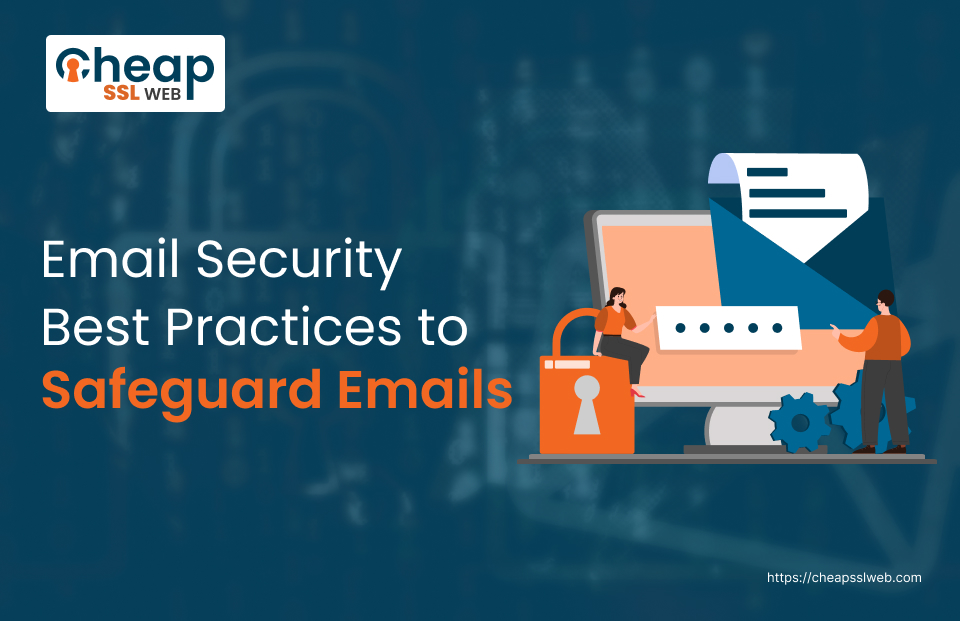Email Security Best Practices to Safeguard Email and Email Server

What is Email Security?
Email security concerns the methods and procedures that are implemented to ensure the security of email communication to provide confidentiality, completeness, and reliability of email communication.
Besides email being the most used communication channel for personal or business information, the need for security to avoid unauthorized access, data breaches or other cyber threats, is vital.
Email security threats comprise phishing, malware, spam, destruction of data files, hacker attacks on email servers, sabotage of bots and DDoS.
The proper manner to solve these threats is the securement of email accounts by sender authentication, a spam filter, multi-factor authentication, using a different email for personal and business emails and avoiding the use of public Wi-Fi, backing-up of critical files, employee education and deploying an email security solution.
What is a Secure Email Server?
The secure email server refers to such a dedicated infrastructure that allows emails to be transmitted, received and stored in a secure manner.
That significantly reduces the risk of confidential information leaking out or being intercepted and modified by unwanted parties.
It offers an integration of encryption, authentication processes, access controls, protocols as well as other protective measures to secure the integrity, availability and confidentiality of email.
The email security server is any computer or system that does the receiving, processing, and transmitting jobs to ensure the protection of email communication against any kind of compromise of the confidentiality, integrity, and availability of communication.
It employs robust encryption methods like Transport Layer Security (TLS) and end-to-end encryption (E2EE). Therefore, data transfers are security-guaranteed to help prevent data breaches.
More importantly, the presence of server certificate authentication systems such as SPF protects an email against tampering by not verifying that the SPF record has been spoofed.
Another prophylactic measure in place is anti-phishing techniques designed to prevent phishing and minimize the effect of this sort of attack.
Protected email servers realize the security of employer corporate cybersecurity due to the important sensitive data stored in the email traffic, to the phishing danger, and because of the fact emails are used to manage access to online, other accounts.
Carrying out email security guidelines, like switching on email security features as well as releasing email security solutions that can detect and eliminate evil sources, will achieve the purpose of ensuring a company’s email – safety.
While solid email server security is no longer the only practice to safeguard against most of the modern email attacks, advanced techniques are still needed as well.
For instance, phishing. A secure email server defends against an attacker whose objective is to use the opportunity of a corporate email server by protecting corporate email servers from unauthorized access and hitting away various types of intrusions through a secure email server.
Key Features of a Secure Email Server
Key features of a secure email server include:
Encryption
This approach embraces the email being encrypted right from when the sender’s device sends the message up to when the recipient’s device successfully receives it.
As for the email server, the plaintext content of the email either remains encrypted or is hardened by PGP keys from outside.
The end-to-end encryption employs cryptographic keys exclusively possessed by the sender and recipient, hence it would be impossible for an unauthorized user, even the service provider, to eavesdrop and decrypt the email in question.
Authentication
Authentication is a process used to verify the identity of an individual or an entity through which individuals or entities confirm they are who they say they are, before being authorized access to a system, service or resource.
It is the basic and core part of cybersecurity and is being applied to protect sensitive information, block access to unauthorized persons and establish integrity of digital systems.
Access Control
In this connection, the term access control entails granting and controlling access to resources or systems in accordance with some set rules and policies.
This process, which targets the eligible individuals for certain assets utilization, specific actions allowed, and the administration of conditional access, is known as resource allocation.
The authentication, authorization, and encryption methods can be used accordingly for access control to prevent unwanted access and to protect from the security threats.
Implement access policies for unauthorized login to email accounts, which only grants access to the mailboxes that belong to authorized workers.
Anti-Malware and Anti-Spam Protection
Bypass filters for dangerous attachments, and phishing emails, Suspicious Emails and catch spam messages, thus, improving email safety.
Secure Email Protocols
Apply protocols like TLS and SSL to encrypt information on email, therefore encryption will happen preventing data from corruption, or it will be accessed by malicious actors.
Recommended: Get Trusted Email Signing or S/MIME Certs & Protect Email Communications
Reverse DNS Configuration
Configure RDNS to associate IP addresses with domain names thus increasing email security and legitimizing.
Email Firewalls
Stand-up email firewalls to intercept spam, phishing attempts, malware, and all other threats that might potentially gain access into the users’ inboxes before an email server or network infrastructure can be affected.
SPF Activation
Implement SPF (Sender Policy Framework) to foil pretending and elevate email security.
SPF activation in email security entails installing the SPF policy to authenticate email messages for the domain name and prevent messages mimicking the original from being tampered with before delivery.
It does this by checking if the servers sending emails for the domain are authoritative for such a task, increasing security of email messages by ensuring they are consistent with the domain’s rules.
SPF activation mandates DNS publication of the SPF record which indicates the list of the mail servers that accept emails on behalf of the domain.
In the moment when an email is received, the SPF record wordt thus checks against the sender’s policies to confirm his compliance with that, which makes it easy to identify false or unauthorized emails.
DMARC Implementation
Adopt DMARC (Domain-based Message Authentication, Reporting, and Conformance) as it works towards protecting the email medium from Threats of spoofing and phishing.
While DMARC can be considered the higher level of the SPF and DKIM protocols, it, in fact, works in conjunction with them.
Recommended: Email Certificate Not Secure: How to Solve the ‘Not Verified’ Error in Outlook
The aim of building out the consistent policies of email authentication. DMARC ties the sender’s domain name to the domain listed in the From: header and above all can help the organization to report to persons in charge. It was created as a defined standard 7489 in 2015.
Best Practices for Running a Secure Email Server
Operating an email server means that you take on the task of protecting a valuable communication device, where you need to guard it against different threats and guarantee its smooth performance.
Choose Reliable Software:
Choose a secure and reliable email server software that has a record of protecting its users and providing on-demand support. Common widely used mail servers are Microsoft Exchange Server, Postfix, Exim, and Dovecot.
Keep Software Up-to-Date:
Routinely update your email server software, operating system, and all the other components associated with it and patch the vulnerabilities they feature with the latest security fixes that can protect them against the new non-existing threats.
Implement Strong Authentication:
Enforce strong authentication techniques like SSL/TLS encryption, SPF, DKIM, and DMARC to check the identities of senders and filtered recipients and to prevent email spoofing, phishing and spamming.
Must have Email Security Best Practices
These steps are also follow for email security check:
Enable 2FA or MFA:
This procedure involves users providing personal information in addition to their password to authenticate access to their email account.
It may include the code word, the thing or the person (security token or smartphone) that you know, something you possess or something you are. 2FA or MFA, as an additional protection level.
Recommended: Multi-factor Authentication (MFA) Vs. Two-factor Authentication (2FA): Key Technical Differences
This makes the email account a tough nut for attackers, as access to the login number alone will not allow them to reach the user’s account even if they have a password.
Use Strong Passwords:
Passwords must be different, convoluted and change frequently.
It must not be given out for other people, and their content should not be reused in different user’s accounts. Password managers may be useful in the tasks of password generation and storing.
Encrypted Emails:
Encrypting email is the way of ensuring that a sender of the message will be the only person who will be able to decipher and read the content of the email message.
Recommended: How to Send An Encrypted Email from Outlook?
It is this encrypted email’s intention to provide data-privacy regardless of the situation that unauthorized users gain access to the email, or internal users send it mistakenly to the wrong recipient.
Secure Encrypted Connections:
Emails need to be also secure in transmission, which means that they should be sent and received via secure connections, such as TLS or SSL. This is done to access the protected line of communication between people and hackers.
Avoid Accessing Email Over Unsecured Wi-Fi Networks:
Public Wi-Fi networks are usually in the open and harder to secure from potential assailants. It is wise that users refrain from checking email from risky Wi-Fi and they would better do it with a VPN available.
Implement a Secure Email Gateway:
A secure email gateway is a security software that makes sure no outgoing and incoming emails are missed with regards to malware, spam, or potential threats.
Policies on data integrity can also prevent the easy transmission of sensitive information via email.
Stay Vigilant for Suspicious Emails:
The email recipients should take care from the time someone sends them unknown emails or with suspicious content.
They should be directed to other relevant websites by avoiding at all costs clicking on the links or downloading email attachments.
Exercise Caution Before Clicking on Links:
Users need to hover with the mouse over the links in emails so that they can determine the destination of the links to be sure that they are going the right way.
They will also need to not click the links coming from unrecognized senders unless their email message content is unknown.
Monitor Organizational Email Activity:
Firms are exhorted to track email operations to report any strange patterns of activity. With this, you can help to counteract data breaches, among other security threats.
Utilize Antivirus Software:
Antiviruses can always be found to be useful in that they can detect and eliminate malware that is hidden in email attachments or links. It is quintessential to keep it in great working order and look through it from time to time.
Keep Software and Antivirus Programs Up-To-Date:
Be sure that you have updated and upgraded software and a scanner virus. Also, be sure to add the latest security updates and patches. Such a measure would thus prevent the perpetuation of known security gaps that the attackers frequently make use of.
Deploy a Strong Email Security Solution:
The best approach includes installing a powerful email security system with antivirus, antispam and antimalware protection inside it. This will help prevent viruses and other kinds of threats from spam mail and will make our organization’s network safe.
Keep Work and Personal Email Separate:
Persons as a practice should hurl off work and home email accounts. This in turn helps to ensure the corporate network is not vulnerable to email-based threats Originating from insecure personal computers.
Conclusion
S/MIME (Secure/Multipurpose Internet Mail Extension) enables you to encrypt outgoing messages and attachments so that only intended recipients can read them. To read the messages, recipients must have a digital identification (ID), also known as a certificate.
Buy S/MIME or Email Signing Certificates of Trusted CA and Protect your Email Communications. Starts at Just $9.49/Year
